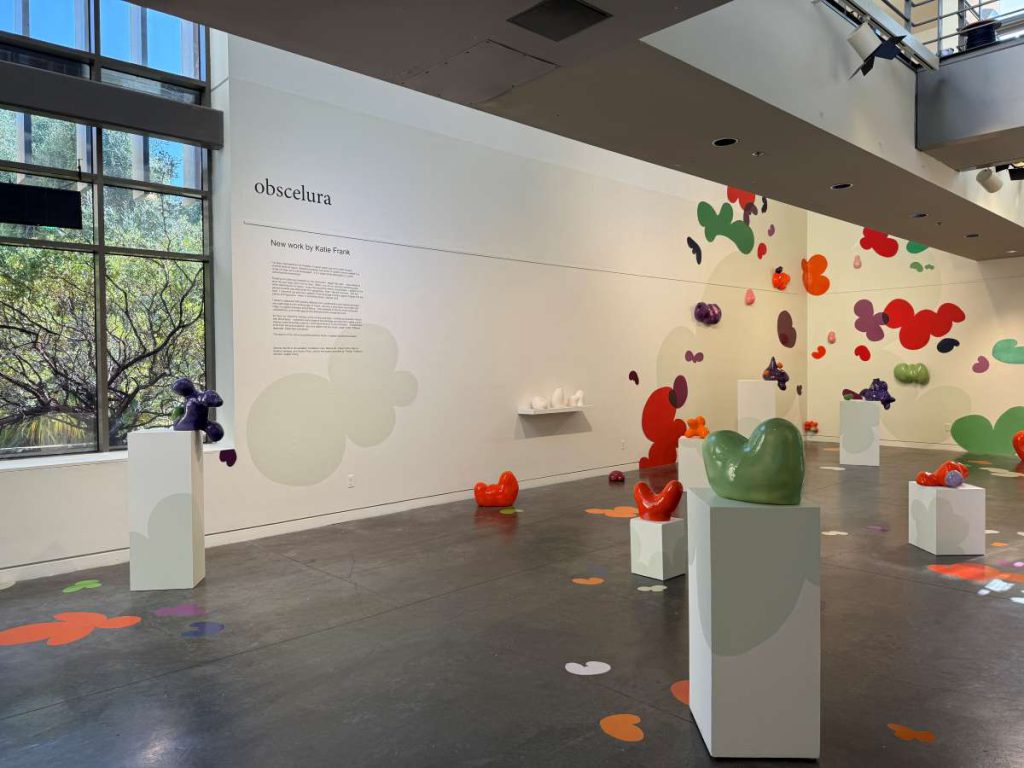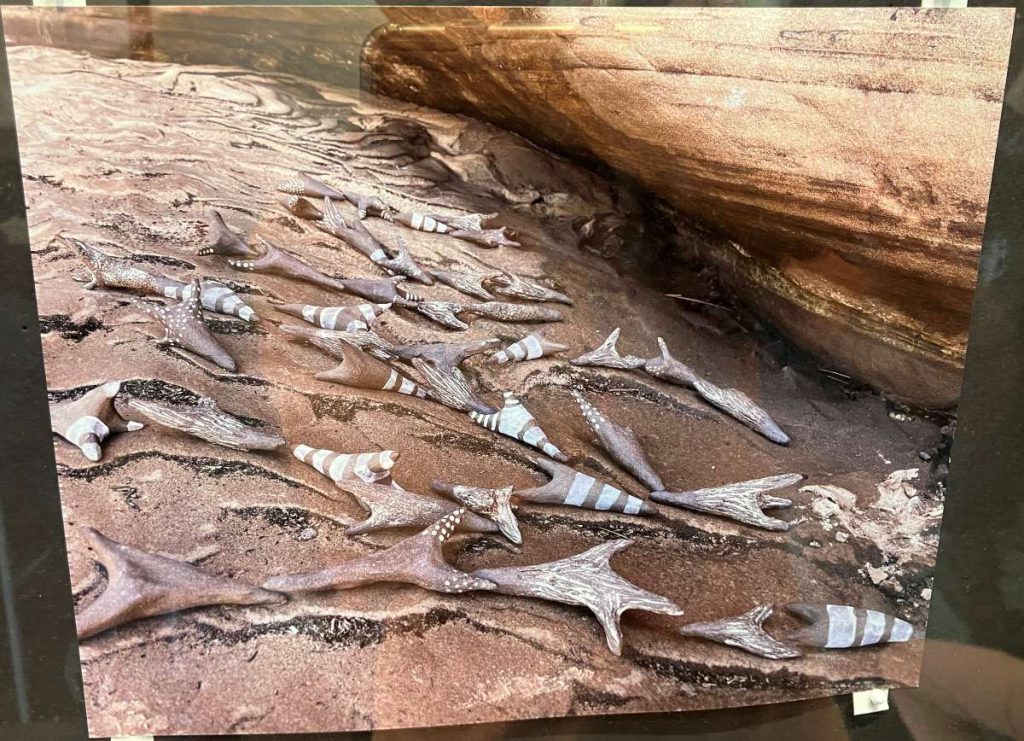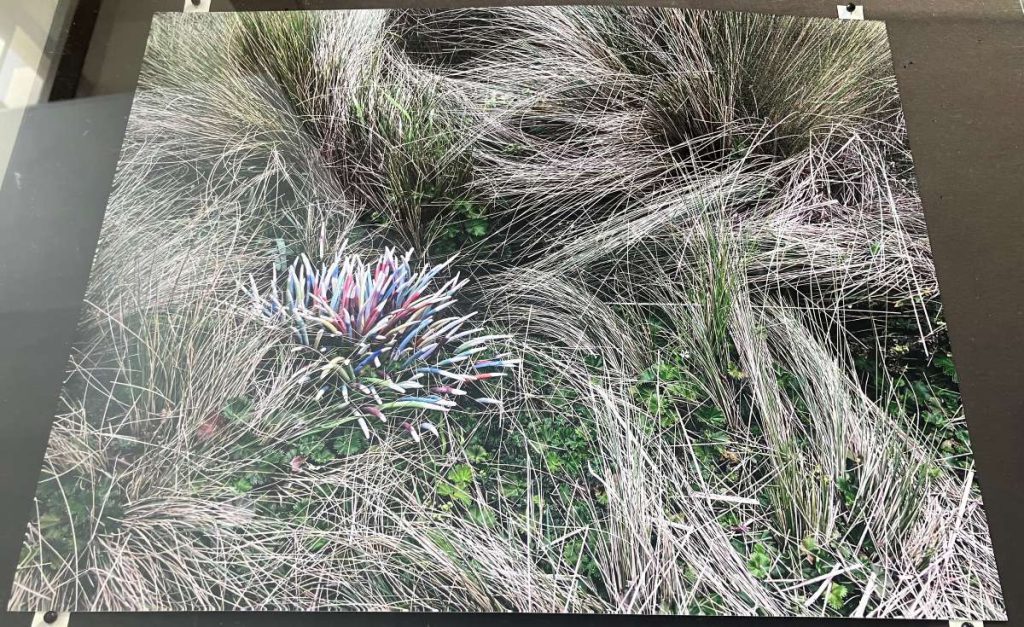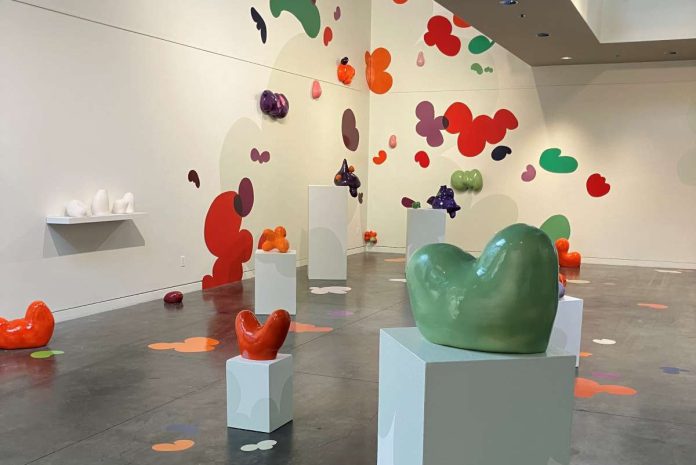On the first floor of the Smith Center at Ohlone College in and around the Louis-Meager Gallery is art professor Katie Frank’s compilation of paintings, sculptures, photographs, and statements in various installations. They create the Obscelura show and exhibit art inspired by the Ungathered project. Painted in monochromes, the shapes of Obscelura are mounded and curved like clouds or—as Frank describes—bodily forms. Some shapes exist separately- even perching in solitude on platforms. Others socialize by covering, superimposing, merging with, or challenging their different colors. Some shapes are decorated by bright hues in stark contrast to the clinical room of the Louis-Meager Gallery, while others are covered in subdued hues that blend in.
The shapes and colors of the sculptures in the pictures developed from Ungathered include more edges, earthy tones, and even patterns. Some shapes resemble animal teeth. Others resemble matchsticks. The backgrounds in the pictures vary from desert landscapes to produce arrangements to a human face to tiled showers. Frank says a part of her artistic process is considering the environment and deciding whether she wants her forms and colors to blend with or contrast the landscape.

In her statement posted on the wall of the Louis-Meager Gallery about the Obscelura show, Frank wrote “I’ve been captivated by the variety of colors and forms within diverse environments for years.” She was cleaning out her studio when she found an old color workshop book and knew that was her prompt. Frank wrote: “I…settled into a language of loopy organic shapes that are playful and figurative- which is…where I always land.” She “wanted to physically interact with the shapes” and “walk inside of the paintings.”
With regards to the Ungathered project and the installations inspired by it, Frank mentioned the art of Andy Goldsworthy and Felix Gonzalez Torres as inspiration. Goldsworthy is known for choosing nature as his tapestry and practicing intentionality in his arrangement to honor and display nature’s features and processes rather than to hide or to fight them. Torres is known for dividing his art for distribution to his audience so that they can take not only the sentiment of his installations but tangible pieces.
Since 2017, Frank has brought and has scattered her ceramic pieces on her travels, either thoughtfully placing them in a natural or urban setting she chooses or giving them to the people she meets. She has asked recipients to upload using a QR code the locations of the pieces as they travel and to pass the pieces on to the next person or landscape. Everpresent are her missions to focus on art appreciation through working with different materials and concepts and to spread community by including others in her art.

Photo of display taken by By Akila Cuddalore

Frank acknowledges that some people may question the art because the pieces initially appear simple. But creating and implementing the show and project was challenging creatively and physically. Some of the origins for these projects lie in gouache paintings in which the color theory shifts dramatically depending on the colors that lie beside each other. Frank noted on cards how different colors and hues interact with each other and arranged and rearranged pieces of wood repeatedly to create visual models in her backyard. She chooses clay and glaze types thoughtfully depending on the background she is envisioning and how she wants the pieces to interact with the environment. Even her application of glaze or placement of the ceramics in the kiln changes depending on the character of the piece.
For the three-dimensional sculptures of the Obscelura show, Frank sprayed paint rather than brushing to avoid unevenness on the forms from brushstrokes. For Roots in the travelling installation project, Frank used earthenware clay of more natural colors and no glaze, resulting in the pieces blending in with the surrounding desert landscape. For Tendrils, Frank glazed the porcelain ceramic sticks on every side except the tips; she did not want the sticks to stick to the kiln due to the glaze. To avoid straightening the forms by resting the entire lengths of the sticks against the kiln surface, she elevated and balanced the pieces so that only the tips were touching the surface. The result was that each ceramic stick developed a unique curve like a blade of grass. But the bright paint and glaze on the sticks emphasized the pieces’ separateness from the meadow they were placed in.
Art has dominated Frank’s life since childhood; her parents took her to art museums and enrolled her in art classes. In expressing her love for art, Frank explains, “I enjoy the surprise and spontaneity inevitable to the artistic process in my own practice. I also enjoy seeing what other people choose to focus on and how they handle their materials.” She has studied many mediums including drawing, painting, glassblowing, clay, and encaustics. Frank decided to become a professor when she was in college. She loved not only making art but seeing how her professors commanded the classroom and materials and what made them great (or not so great.) Frank reflects: “My journey as an artist has changed a lot. As I continue to evolve as a person, my art grows with me.”
To learn more about Frank and her art, visit her websites www.katiefrank.com and ungather.org and her exhibit which will be on display at the Louise-Meager Gallery of the Smith Center of Ohlone College from Monday through Thursday between 11 a.m. to 4 p.m. until October 9th.




